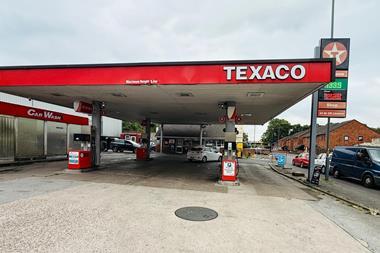Record fuel prices and the economic downturn mean the temptation for motorists to drive-off without paying for fuel taken from your forecourt has never been greater. And with confirmation from the British Oil Security Syndicate (BOSS) that cash losses from drive-offs rose 19% last year, keeping careful track of the fuel in your tanks has never been more critical. Which is why the role of a comprehensive wet-stock management system on a busy forecourt has become even more essential, because among its many benefits is its role in detecting and minimising fuel theft.
Michelle King, operations director at Fairbanks, says: "Our ibank service will detect a drop in stock level when no sale has been recorded. This alert is passed onto the operator very quickly and can allow them time to call the police."
It’s this kind of real-time data that can prove invaluable to the busy retailer, and systems have moved on considerably over the past few years.
As Phil Prow, sales and marketing director of Brulines Fuel Solutions (BFS), says: "It used to be purely about detecting leaks in response to environmental legislation, but it has now become much more sophisticated and become an important management tool that gives those who use it a major advantage over those who don’t.
"It has stopped being just an insurance policy for when something goes wrong and become a real tool that can help forecourt operators manage their sites better on a day-to-day basis," adds Prow. "The real-time accuracy of the continuous fuel monitoring systems that we now provide detects overnight theft (a growing problem), small leaks, meter drift, rogue meters, hot product losses and slow flow, which can result in queues and loss of customers. Catching meter drift early minimises losses, and identifying exactly which meters are affected reduces servicing costs."
Retailers who adopt a comprehensive wet-stock management solution benefit by having a service that takes away the uncertainty of managing wet stock, and allowing them to focus more time and effort on shop sales, says Gareth Jenkins, customer relationships manager at Fairbanks. "The challenge for retailers is to constantly make their business profitable and avoid unnecessary costs. With fuel margins being so tight, avoiding as much wet-stock loss as possible is vital. A major leak could put them out of business. Having access to accurate information is vital for a retailer to make the right business decisions.
"A wet-stock management service must also be able to identify losses that are due to over- or under-dispensing pumps, short deliveries and theft," he adds. "It should have an easy-to-use website that allows users to enter data, create management reports and review trends at any time, and allow site staff to focus more on the shop sales and customer service by removing the need to interpret wet-stock figures that they may not understand.
"There’s reassurance that a dedicated analyst is looking after their data and has their best interests in mind while providing wet-stock advice when needed, and it removes the need for statutory tank testing by providing a Petroleum Officer with the information they need. Above all else, it must save the operator time and money by reducing their wet-stock loss as much as possible from leaks, theft and poor accounting."
Costs for Fairbanks’ ibank service start from £2.50 per site per day for the basic level. "The best service levels can record every transaction and pinpoint a line leak or pump fault faster than ever before," says Jenkins. "It constantly records stock levels to identify any unusual changes in stock that indicate a leak from the tank or theft at night; relays stock levels to a website or mobile device to give operators the information they need to check stock levels and avoid stock-outs; collects and relays alarms from the tank gauge to an analyst or operator ensuring it is not missed by the site staff; collects temperature information to give the operator extra information about their stock levels; and analyses pump flow rates to quickly detect a problem."
The service provides real-time data on demand to give live stock-level data online or on your mobile, reports on pump usage and pump down-time, alarm reporting to ensure site staff don’t miss a critical alarm, water reporting which reacts to increasing water levels before the gauge alarms, and daily, weekly or monthly reconciliation to ensure accounting reports are correct.
Fairbanks’ Michelle King says: "Retailers need to ensure site staff are more knowledgeable about the risks of wet-stock leaks and what they can do to prevent this. Fairbanks offers wet-stock training courses to staff and owners who want to know more and help avoid a costly mistake."
In the past year Fairbanks has continued to work on its management reports to make life easier for retailers. Developments include night-time theft alert where sudden reductions in stock level caused by theft are relayed to the operator in real-time. The service is available free via text message or via a phone call 24 hours a day for £5 per site per month.
The company has also launched a tank temperature analysis report service, which takes into account the sales volumes and temperature averages for each tank over a 12-month period. Bob Conlin, managing director of Fairbanks, says: "The report highlights to dealers their average temperatures and how they could save with automatic temperature compensation pumps."
Temperature analysis gives retailers full information about the thorny issue of fuel changing volume significantly depending on its temperature. As this varies the volume of product in the tanks, on a high-volume site it can have a real impact on profits, says Bruline’s Phil Prow. "Temperature analysis of deliveries and underground storage tanks is invaluable for site operators when considering fuel supply agreements and automatic temperature compensation on dispensers," he says.
The wet-stock management that BFS provides is continuous fuel monitoring (CFM), fundamentally different from traditional statistical inventory reconciliation (SIR) as the system has a real-time link to the site controller to capture every transaction, applying an inventory level and temperature reading to each. These numerous daily data points mean the system identifies smaller losses with greater speed and accuracy than was previously possible.
Meanwhile, Gilbarco Veeder-Root’s Automatic Tank Gauging (ATG) systems are the global benchmark for automated inventory and environmental control, claims the company.
The UK market has adopted them with enthusiasm with more than 75% of sites now equipped with the sophisticated TLS-350R automatic tank gauge.
In addition to providing comprehensive inventory data Gilbarco Veeder-Root ATG systems can provide delivery variance reports with estimated delivery temperature to reconcile the actual amount delivered against what has been paid for; temperature variance reports to eliminate virtual losses from the reconciliation equation and give clarity to variance control and reduction; theft detection with automated alarm notification to guard fuel assets when the site is unattended; and certified precision tank testing at any chosen time for additional peace of mind about underground tank tightness.
The Gilbarco system can also provide dynamic reconciliation of sales versus tank-level changes, as the site trades, serving as a watchdog to make sure nothing disappears between tank and nozzle; and precision line leak detection for pressure systems for automated line testing and shutdown on leak events.
Later this year the company will be launching new services which include the ability to detect meter drift, real-time variance analysis to reduce losses and quiet period theft detection. These services will be provided on a variety of gauge types.
But Patrick Forsythe, managing director of Gilbarco Veeder-Root’s Wet stock Management Business Unit, says that all too often site operators do not realise what a powerful tool they have at their disposal to enhance their wet stock and risk management processes and procedures.
"Although this source of valuable data is available from the ATG at the point of impact on site, where leak and loss events actually occur, it is often overlooked," he says.
"Additionally, the data can be utilised remotely for greater network control, either with self-managed Gilbarco Veeder-Root networkable applications, or as part of our fully managed wet stock management service."
new service from Gilbarco
To respond to the changing dynamics and challenges in our marketplace, Gilbarco Veeder-Root has formed a new Wet stock Management (WSM) Business Unit by combining its Automatic Tank Gauging (ATG), Fuel Management Services and Technical Support teams.
Led by managing director Patrick Forsythe, this new business supplies equipment to the retail and industrial markets, while at the same time providing end-to-end wet stock management solutions through a range of new and innovative services.
These services are focused on providing Gilbarco customers with increased business and operational performance by reducing fuel losses; improved environmental protection and risk reduction; on-site services; and improved logistics and scheduling through its partners.
"Our customers want solutions and to this end we have strengthened our organisation to answer their needs," says Forsythe. "We have strengthened our operational capability by integrating our technical support team and fuel management services to form a stronger support team.
"When these are combined with the onsite service teams, we will provide seamless end-to-end solutions for our customers. Our aim is to provide best in class services in the UK and mainland Europe."
BLUE BOOK
The revised third edition of Design, Construction, Modification, Maintenance and Decommissioning of Filling Stations (also known as the Blue Book) was published jointly by the Energy Institute (EI) and the Association for Petroleum and Explosives Administration (APEA) in June. The latest edition has been developed under the EI’s Service Station Panel, with considerable technical input provided by the UK’s Health & Safety Executive, Environment Agency, trade associations and other organisations.
In this revision, the section covering leak containment and leak detection systems is brought up to date with the latest innovations and advancements. The guide aims to raise standards of health and safety and environmental protection by explaining the options available to site operators dependent on the level of risk and the type of tank and pipework installation. SIR-based remote monitoring is compared with alternatives such as automated alarms from tank gauges and real-time analysis makes an appearance.
The guide can be purchased from the Energy Institute or APEA.


























No comments yet